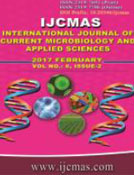


 National Academy of Agricultural Sciences (NAAS)
National Academy of Agricultural Sciences (NAAS)

|
PRINT ISSN : 2319-7692
Online ISSN : 2319-7706 Issues : 12 per year Publisher : Excellent Publishers Email : editorijcmas@gmail.com / submit@ijcmas.com Editor-in-chief: Dr.M.Prakash Index Copernicus ICV 2018: 95.39 NAAS RATING 2020: 5.38 |
Chronic suppurative otitis media (CSOM) is chronic inflammation of middle ear and mastoid cavity with recurrent ear discharge lasting for more than 6months. Studies are mainly done on the bacterial aetiology of CSOM, but very little is known about the fungal aspects of such cases. Otomycosis is increasing in the recent years because of the indiscriminate use of broad-spectrum antibiotics, corticosteroids, and an increase in the number of immune deficiency disorders. The study aimed to find out the fungal agents responsible for causing CSOM among the patients who attended the Department of ENT in our hospital. 170 patients having chronic suppurative otitis media of all age group and both sexes were selected for study from April 2014 to December 2015. Ear discharge was collected under aseptic precautions using sterile cotton swabs and fungal culture was done. A total of 170 patients who were clinically diagnosed with CSOM were included in this study. Of which 104(61%) were females and 66(39%) were males. Fungus isolated from 87(51.2%) cases. Main fungal isolates were Aspergillus species 67(77%) followed by Candida species 10(11.4%). CSOM with otomycosis produce serious complication and treatment failure. So fungal infection should be suspected if the discharging ear is not responding with antibiotics and fungal culture should be done in refractory cases before starting antibiotic therapy.
 |
 |
 |
 |
 |